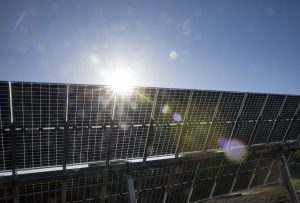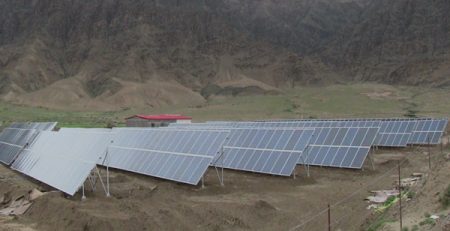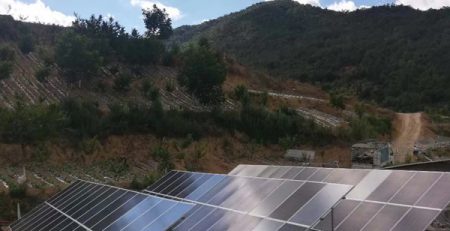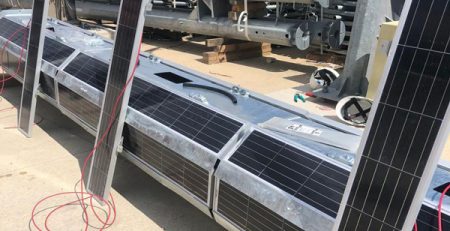SINGLE-AXIS SOLAR TRACKING FOR THE NEXT 30%
NEXTracker has refined its successful NX Horizon single axis tracker into the rugged two-in-portrait NX Gemini. The new design opens up land once considered too rough to be developed to generate near comparable amounts of electricity, while easing land use stresses.
NEXTracker is launching a single-axis tracker, with two-in-portrait solar modules (2P) – the NX Gemini (pdf specification page). The product has been designed for developing solar power plants on sites “with challenging soils, high winds, and irregular boundaries”.
The NX Gemini does this by controlling torsional and dynamic wind forces through a series of distributed gear systems, as well shortening the length of units by a third. With shortened row lengths, designers are able to make greater use of irregularly shaped and undulating land.
Talking with pv magazine USA, NEXTracker’s CEO Daniel Shugar (Shug) said this undertaking involved first principle design considerations:
NEXTracker is launching a single-axis tracker, with two-in-portrait solar modules (2P) – the NX Gemini (pdf specification page). The product has been designed for developing solar power plants on sites “with challenging soils, high winds, and irregular boundaries”.
The NX Gemini does this by controlling torsional and dynamic wind forces through a series of distributed gear systems, as well shortening the length of units by a third. With shortened row lengths, designers are able to make greater use of irregularly shaped and undulating land.
Talking with pv magazine USA, NEXTracker’s CEO Daniel Shugar (Shug) said this undertaking involved first principle design considerations:

Shug told us that when the company’s first single axis tracker was designed – the NX Horizon – it was aimed to hit the center part of the market. The market of reasonable wind speed, soil and topography. The product gained NEXTracker a 30% market share, and Shug modestly suggested it, “it worked really well for us”. Now, as the solar industry has expanded, it was time to begin work on a second product line.
Considering the costs of the new hardware, from a direct cost per watt measurement, the NX Gemini is more expensive. However, the fact that it can carry more wattage per each of those heavier foundations, and that its stouter stature allows you to squeeze in a greater number of individual rows onto irregular sites, plus a bit more nuance in that every site has variability – means that the use case often drives costs tighter with the original NX Horizon pricing.
When a project is delivered, below image, it comes with a 10 year structural warranty, and a five year drive and control components warranty – meaning there will be operations and maintenance requirements, unless fixed racking. As, well, the hardware comes with PE stamped structural calculation and drawings, along with onsite training and final system commissioning after construction is complete.
The racking system is driven by all mechanical means, meaning no cables, no open teeth, no open pulley, and everything is enclosed, while also up in the air. The hardware is most located at or above head height, meaning no contact with most body parts was specifically noted. Shug noted this takes the hardware out of harm’s (snow, flood, dust, dirt, and livestock) way.
Things still break though, and one additional benefit that NEXTacker brings to the table is that the thinking part of their product is manufactured by Flextronics, one of the world’s largest manufacturers. And while racking companies don’t have a cool bankability list like solar modules do, Shug suggested that the largest development groups do have a list – and suggested that you want a company like NEXTracker because there are plenty of sites, with out of business tracking companies, who did very expensive rebuilds with new hardware.
In Washington State grazing revenue for one site went from $2/acre/year to $300/acre/year. In Texas in 2017, wind and solar energy provided landowners with an estimated $90.4 million in land lease payments. In California, farmers are “planting solar panels” as water supplies dry up.
As a writer and a solar power developer, I hear from many landowners seeking to gain revenue from their sites. Not every site makes sense, for many reasons – state level laws being the biggest of drivers. But maybe now, there’s one fewer reasons to not go solar.





